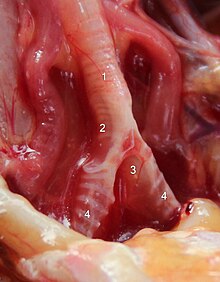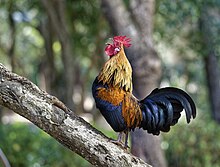User:Opzwartbeek/Cock-crowing

[[Datei:KrährufBergischerKräher.ogg|thumb|The crowing of a Long-crower (bergischer Kräher)]] Cock-crowing or rooster-crowing is the typical acoustical utterance of the male domestic fowl.
Biomechanics[edit]

In birds, vocalisation takes place in the syrinx, an organ consisting of muscles and cartilage. In the case of chickens, this organ is localised between the distal parts of the trachea and the main bronchi. Sounds are amplified by moving parts of the tracheal and bronchial wall, the membranae semilunares or tympaniformes, which serve as a resonator. Compared to singing birds, the muscle complex of the syrinx is relatively simple, restricting the modulation of sounds.[1] The length and volume of the crow is regulated by size and filling of the lungs as well as by the function of cervical, thoracal and abdominal muscles.[2] Der im Stimmkopf aufgebaute Druck muss für die Lautbildung den Druck in den infraklavikulären Luftsäcken angleichen und kann wechseln zwischen 6 und 50 mm Hg.[3]
Endocrine Regulation[edit]
Crowing is a sound, which is almost exclusively present in mal fowls. The hormonal influences were discovered in one of the first and historically most important endocrinological experiments. Arnold Adolf Berthold removed the testicles of several cocks an re-implanted them in some of the animals. After castration the cocks all stopped crowing. The cocks which underwent re-implantation started crowing immediately thereafter.[4] Crowing of hens has already been discribed by Aristoteles, though only in the case of victorious behaviour.[5] Hormonal influences can lead to a persisting crowing in hens, oft by ovarial diseases or simple age dependent atrophy.[6]
Crowing characteristics of the jungle fowl[edit]

The four genus of the jungle fowl, have different crowing Patterns. Differences exist in the number of syllables, the length, accentuation, sound structure and pitch. The green junglefowl crows relatively high-pitched and bisyllabic. The Sri lankan junglefowl crows with three syllables and a prolonged interval between first and second syllable. The grey and red junglefowl crow with four syllables. The grey junglefowl stresses the second, the red junglefowl the thirth syllable.[7][8] The fact that the crowing of the domestic fowl is four-syllabic and correspends with the sound of the red junglefowl, is being seen as an Argument for Darwin's monophyletic theory on the roots of domestic chicken.[9][10]
Einzelnachweise[edit]
- ^ Bernd Vollmerhaus: Lehrbuch der Anatomie der Haustiere, Band 5, Georg Thieme Verlag, Erlangen 2004, S. 166
- ^ John Ludders: In: Dukes’ Physiology of Domestic Animals, John Wiley & Sons, New Jersey 2015, Kapitel 26
- ^ W. B. Gross: Voice production in the chicken, Poultry science, Vol. 43, Nr. 4, S. 1005–1008, Oxford 1964
- ^ Arnold Adolf Berthold: Transplantation der Hoden.
- ^ Aristoteles: Historia animalium, Buch IX, Kapitel 49, Hrsg.
- ^ Thomas R. Forbes: The Crowing Hen: Early Observations on Spontaneous Sex Reversal in Birds, Yale Journal of Biology and Medicine, New Haven CT 1947
- ^ Nicholas und Elsie Collias: A Field Study of the Red Jungle Fowl in North-Central India, in: The Condor, Vol. 69, Nr. 4, S. 360–386
- ^ Gail Damerow: Storey’s Guide to Raising Chickens, 3.
- ^ Sawai, Hiromi, et al.: The origin and genetic variation of domestic chickens with special reference to junglefowls Gallus g. gallus and G. varius, PloS one 5.5 (2010): e10639.
- ^ Charles R. Darwin: The variation of animals and plants under domestication, John Murray, London 1868.
[[Category:Ornithology]] [[Category:Animal sounds]] [[Category:Ethology]]
